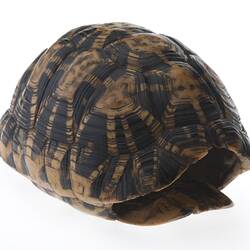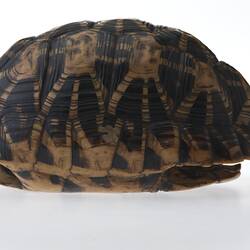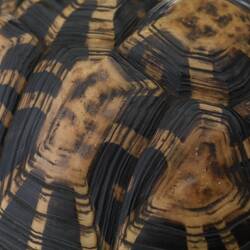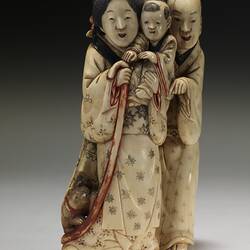Summary
Tortoise shell from an Indian star tortoise (Geochelone elegans), native to the dry scrub land jungles of southern India and Sri Lanka.
The upper, or back, convex part of any tortoise shell is known as the carapace. The exterior of the carapace is covered in a series of shields or scales called 'scutes' that give the shell its distinctive pattern and colour. The Indian star tortoise has particularly decorative scutes with a light-coloured star pattern against a dark background, from which the animal derives its name. Often these scutes can form small humps, giving the shell a particularly textured surface. The highly contrasting pattern of the shell is a form of camouflage, breaking up the tortoise's outline and allowing it to more effectively conceal itself in grass or scrub.
Indian star tortoises tend to be largely herbivorous, feeding on grasses, fruits and other plants, and generally are considered to have a life expectancy of around 30-40 years, although there are reported cases of some tortoises living up to 80 years of age. The female tortoises grow larger than the male, averaging around 30-40cm in length, compared to about 18-25cm for the male tortoise.
A wide variety of animal products from the Indian subcontinent were exhibited at the 1880 Melbourne International Exhibition at the Ceylon (Sri Lanka) Court under Class 29, which included decorative leather-work, fancy articles and basket-work. Ebony cigar cases and ink wells, ivory carved elephants and elephants' teeth, porcupine-quill workboxes, and tortoise-shell boxes were among the many unusual products on display that would have appealed to Victorian collectors for their oddity as much as their decorative value.
Physical Description
Tortoise shell. Ornamental specimen.
More Information
-
Collection Names
-
Collecting Areas
-
Acquisition Information
Cultural Gifts Donation from Dr Will Twycross, 23 Jan 2009
-
Acknowledgement
Donated through the Australian Government's Cultural Gifts Program
-
Place & Date Exhibited
Royal Exhibition Building (REB), Nicholson Street, Carlton, Greater Melbourne, Victoria, Australia, 1880-1881
-
Collector
Mr John Twycross, Elsternwick, Greater Melbourne, Victoria, Australia, circa 1881
-
Inscriptions
Handwritten on white sticker stuck to underside: TORTOISE SHELL -/ AFRICA [sic].
-
Classification
Royal exhibition building, International exhibitions, Exhibition heritage
-
Category
-
Discipline
-
Type of item
-
overall dimensions
129 mm (Width), 85 mm (Depth), 63 mm (Height)
-
Maximum dimensions
120 mm (Length), 83 mm (Width), 58 mm (Height), 243 mm (Circumference)
Measurement From Conservation.
-
Keywords
Exhibitions: Melbourne International, 1880-1881, Royal Exhibition Building, Tortoiseshell, Indian, Animal Products




